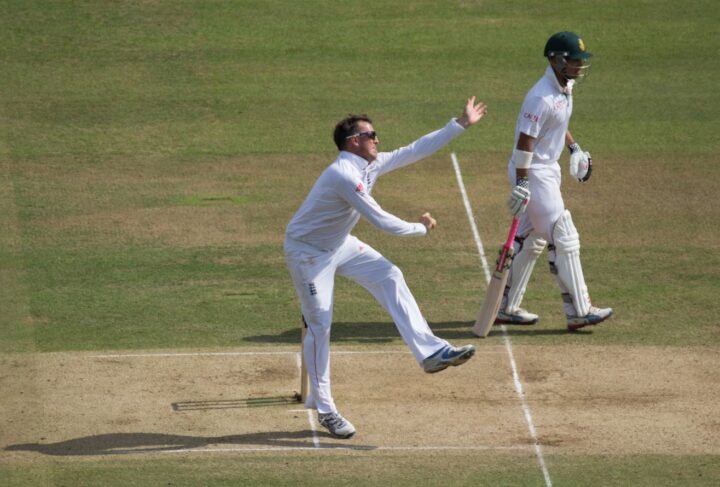Since its dawn in 2003, the T20 format has taken over cricket. Last year alone, there were a whopping 536 T20 international matches, including a successful World Cup alongside an array of domestic leagues and franchises. The format has been around for a mere two decades, yet has undergone a host of tactical developments. The explosion of mystery spin is an obvious example, with loopy leggings gaining favour for their variation in the shortest format. However, the T20 game’s most prominent tactical development has surely been the rise, and fall, and slight rise again, of the anchor.
In a format obsessed with massive sixes and high strike-rates, the anchor plays a calming role. They typically bat at a lower tempo to stabilise the innings while rotating the strike to maximise the number of deliveries faced by the biggest hitters. In the early days, sides were filled with anchors: England’s first ever T20 side included the likes of Andrew Strauss and Michael Vaughan, fine cricketers, but not exactly known for their attacking prowess.
As the game grew throughout the 2010s, the position became more specialised. Big hitters grew in popularity although one or two players, typically coming in at three or four, would still try to anchor the innings. Think JP Duminy. The busy South African averaged an impressive 38.68 in his 81 match T20I career, striking at a slowish 126.24. This complemented the bigger hitters around him like AB de Villiers and Faf du Plessis. This formula worked; therefore almost everyone adopted it. England had Joe Root; Australia, Steve Smith; India, Virat Kohli; and New Zealand, Kane Williamson.
Yet, in the past five years, as it has throughout its lifetime, T20 cricket has evolved again. A handful of sides have opted to drop their anchor altogether, instead favouring more destructive options both up top and in the middle order. Joe Root was an early victim of the cull, being dropped in 2019. Despite an average north of 35, the Yorkshireman’s strike rate of only 126.30 was deemed too pedestrian for England’s T20 side. Australia too have dropped their anchor, the great Steve Smith being replaced by 6 ft 5 inch, six-hitting-machine, Tim David.
On the other hand, a number of nations have stuck with their anchors. Kiwi captain Kane Williamson remains a stalwart, despite his leisurely 123.01 strike rate. The ‘king of chases’, Virat Kohli, is known as being a dasher but he often guides his side to victories at a steady pace – as does Pakistan skipper Babar Azam, despite mounting criticism over his sedate style.
The message from the nations that have dispensed with their anchors is clear: batters are getting better and totals are getting bigger; therefore quick runs throughout the innings are a must, especially during the powerplays. Anchors simply bat too slowly for modern T20 cricket.
But do they? And what, exactly, is too slow?
Pakistan’s chief selector, Shahid Afridi set his T20 stars the benchmark of a strike-rate north of 135 as a requirement for selection. Yet a strike-rate of 135 isn’t always what’s needed. Take England’s victory in last year’s World Cup final, for example. Ben stokes heroic 52* came off 49 balls at a strike-rate of only 106.12. Stokes’ slow and steady knock was just what the doctor ordered.
Chasing a meagre 138 to lift the trophy, Salt, Brook and Hales all lost their wicket in pursuit of quick runs that weren’t really needed. Instead it was the cautious and experienced Stokes, anchoring the innings, who led his team to victory. Indeed, the chase might have been even more comfortable had Root been in the XI to settle the nerves.
This isn’t the first time that less than gung-ho batting has paid dividends in a T20 World Cup. Marlon Samuels’ defiant 85* (66) helped the Windies snatch a seemingly impossible victory in the 2016 final. In the 2021 tournament, Babar Azam scored the most runs at a strike-rate of only 126.25, while Kane Williamson guided his side to the final at a sluggish 115.50.
For Williamson, Babar, Samuels and Stokes, these runs weren’t too slow; they were as fast as their teams needed. And, in the latter two cases, they were fast enough to win the tournament. ‘Fast enough’ therefore isn’t a predetermined metric; there’s no magic number that determines whether a T20 innings is inherently good or bad. Stokes 52* (49) would be useless in an all-out slogathon at Eden Gardens. But sometimes, when the bowlers are on top, patience and good technique still pay dividends.
Consequently, modern T20 cricket still has plenty of room for anchors. Indeed, there’s a smorgasbord of situations – big boundaries, tricky pitches, low totals – in which batsmen that pace themselves are invaluable. And, typically, these situations and conditions occur at some point in most tournaments. In fact, scores are often lower in the knock-out stages when the pressure is really on. Therefore, anchors are frequently essential at the business-end of big tournaments.
However, the inclusion of an anchor can a double-edged sword. Should a side select one, there’s always the risk that they bat unnecessarily slowly, chewing up balls while the more brutal bats are made to wait. Take Virat Kohli’s mercurial 2022 World Cup campaign, for example. King Kohli was picture perfect in India’s historic, early-stage chase against Pakistan. He started slowly, 11 off his first 20 balls, before exploding in the latter overs. Kohli demolished Pakistan’s quicks with a flurry of powerful pulls and sumptuous drives. Particularly divine was his swat down the ground to Harris Rauf – a glorious illustration of timing and balance in the penultimate over. The masterful knock guided India to a crucial victory, the perfect example of how and why a batter should anchor innings.
Yet, a mere 18 days later, Kohli got it completely wrong. He limped to 50 off 40 balls in the semi-final, with the dynamic Rishabh Pant waiting in the wings. His sluggishness restricted India’s total to just 168 – a target that was surpassed with a staggering 24 balls to spare by England’s destructive openers.
Of course, there’s obvious risk in loading a team with big hitting batters, too. That’s why the most valuable players are those who can adapt. Although I previously distinguished England’s Test skipper for his sensible batting in the World Cup final, Stokes is not always an anchor. His role for the three lions and in franchise cricket is to bat aggressively at the top of an innings, making quick runs in the powerplay and middle order. However, when the situation requires a softer touch, Stokes rises to the challenge and adapts his approach accordingly.
Perhaps, therefore, Stokes is the blueprint for the anchor’s future: players who can dig in when required but also shift their style should the situation demand it. It’s interesting that Joe Root has been plying his trade for Dubai Capitals in the inaugural ILT20 league. Earning his franchise stripes, the Yorkshireman unfurled reverse-sweeps and ramps-a-plenty in his five games, hoping to prove that he too can up the ante on a regular basis. Steve Smith also played well for the Sydney Sixers in the Big Bash.
T20 cricket will always be a batter’s game. But there will always come times when a softer touch is required. So yes, anchors still very much have a place in T20 cricket. But there’s no room for passengers. Batsmen without the capacity to move through the gears risk sinking the ship.
Will Symonds









Well T20 is such a mixed up sort of game that it won’t be long before each side has a pinch hitter who may be substituted at the discretion of the captain. It would mean that the so-called anchor could be used and brought in if the side batting second was chasing a low score and needed the sort of application outlined in the article. Alternatively a squad from which the captain picks eleven prior to the start of their respective team’s innings.
I’m not sure there’s an anchor role in 20-20 as you’re looking for runs off every ball to keep the initiative. Look at those who’ve played a comparative one in ODI’s and they’re all experienced pros like Malan, Root, Stokes and occasionally Buttler. Even then you have to be able to adapt to up the anti mid innings as otherwise all the pressure is on the man at the other end. The young player brought up on a main course of white ball with only a starter of red hasn’t got it in their make up. It’s a judgement call on when to play what shot and that can depend as much on the field setting as the state of the game, which is one of the reasons so many shots look so bad if they don’t work out. My prime gripe is the fixation with hitting sixes rather than keeping the ball on the ground with fours to minimise the likelyhood of a catch. Players have been brainwashed into thinking fours are a disappointment. All the boundary stats are about sixes. The way the game is being marketed lends itself to this dumbed down approach to keep the punters attention on every ball.
Excellent article. I would have loved to see Chris Tavare play T20
Tavare wasn’t a bad limited over player. It was test cricket that scuppered his ability to hit the ball off the square. I would have given a lot to see Boycott trying his luck with ramp shots and the look on his face to see his protege Root reverse sweeping sixes.
Watching some of the recent Kuwaga marathon bought back not so happy memories of being out through the mill as a punter by the ‘thou shalt not pass’ brigade that every county seem to have in the 60’s and 70’s as he exaggeratedly pushed back one half volley after another on a great batting surface. Maybe Bazball’s not such a bad idea after all.
Does the need for an “anchor” depend on the number of bowling options selected? If six bowlers then potentially a more cautious player is required?
Also with modern bats, short boundaries, etc. lower order batsmen (Curran & Jordan) are adapt at clearing the boundary and scoring 10 runs off 5 balls – so somebody taking it deep to allow these to play without restraint